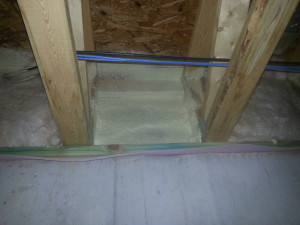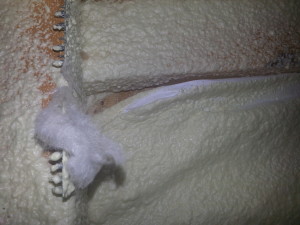Insulation Foam Spray Kansas City: Why Flash and Batt is a Bad Idea
During the building process, there are many ways to try to cut costs. And while some of these make good sense, one that generally does not is using a flash and batt wall system for your insulation. Flash and batt uses closed cell spray foam insulation as an air barrier, and then a fiberglass batt or blown in fiberglass or cellulose insulation is installed over the top of the spray foam insulation. If you’re making insulation decisions, particularly related to insulation foam spray Kansas City, read on to learn more about this option as it very well may come up during your build.
While we have seen this wall system used many times, it is not one we recommend. In fact, a quick Google search will turn up horror stories of this system failing. Here’s just one example where a hybrid system was initially installed and then ultimately corrected after the immediate appearance of moisture issues. In cold climates, flash and batt is particularly problematic. In cold climates, vapor drive comes from the interior of the home, driving outward through the fiberglass insulation, creating condensation on the cold surface of the spray in foam insulation. The key for this to work is that the spray foam insulation has to be applied at a sufficient thickness so the surface of the spray foam will not be cold, depending on your climate.
Thickness Counts: Insulation Foam Spray Kansas City
As referenced in the example above, thickness counts when it comes to this combined system’s function. We see lots of applications where the closed cell spray foam insulation is only applied ¼ inch to ½ inch thick. This is not thick enough to prevent the cold from penetrating the spray polyurethane insulation. In most climates, you will still have problems up to 1-inch thick with this system. When the warm, moist air from the interior of the home comes through the fiberglass or cellulose it hits the cold surface and condenses. This moisture is then trapped in the wall and can lead to mold problems.
 As you can see from this photo, the spray foam insulation installed doesn’t look like much more than a poorly done paint job. For a flash and batt system to function as intended, the spray foam insulation needs to be sprayed at least 1 ½ inches to 2 inches thick. In fact, most closed cell spray foam insulation needs to be at least 1 ½ inches thick to reach a less than 1 perm rating and be considered a vapor retarder. Remember, vapor barriers should be on the warm side of the wall. With a flash and batt system, you could end up with vapor barriers on both sides of the wall, trapping moisture inside the wall cavity.
As you can see from this photo, the spray foam insulation installed doesn’t look like much more than a poorly done paint job. For a flash and batt system to function as intended, the spray foam insulation needs to be sprayed at least 1 ½ inches to 2 inches thick. In fact, most closed cell spray foam insulation needs to be at least 1 ½ inches thick to reach a less than 1 perm rating and be considered a vapor retarder. Remember, vapor barriers should be on the warm side of the wall. With a flash and batt system, you could end up with vapor barriers on both sides of the wall, trapping moisture inside the wall cavity.
Even very skilled applicators struggle to install spray foam insulation perfectly flat. This can pose a problem when you intend to install fiberglass batt over the top of the foam. It will leave gaps and air passages that allow convection currents inside the wall cavity. This transfer of air carries moisture. The alternative is to compress the fiberglass, however this renders it ineffective.
Another problem related to thickness is that most manufacturers will not warranty closed cell spray foam insulation less than 1 inch thick. It takes at least a 1-inch thick pass to get a good exothermic reaction to create quality closed cell spray foam insulation. You don’t want a system that won’t be covered under warranty from the start.
Foam Insulation Companies: Quality and Cost
 When you go with a flash and batt system, you’re also relying on two different insulation applications to be installed correctly. The main reason people look to this hybrid system is to reduce cost and get an air seal. However, there is a much better (and possibly more cost effective way) to do this – research open cell foam insulation. Open cell foam insulation, nearly filling the cavity gets the desired R-value and air seal for the same cost or less.
When you go with a flash and batt system, you’re also relying on two different insulation applications to be installed correctly. The main reason people look to this hybrid system is to reduce cost and get an air seal. However, there is a much better (and possibly more cost effective way) to do this – research open cell foam insulation. Open cell foam insulation, nearly filling the cavity gets the desired R-value and air seal for the same cost or less.
We know you have many options when it comes to your insulation project. As you’re researching foam insulation companies, we hope you will call on the KC Spray Foam experts. We are always available to answer any questions you might have and to provide a complete bid for your project.
About the author
Mark grew up in Winterset, Iowa: the birthplace of John Wayne and the home of Madison County Covered Bridges. He lived on a small acreage where they raised cattle, sheep, and chickens. During his youth, he raised and showed cattle with the local 4H program.
Mark’s first paying job was working at the local lumberyard after school and on weekends. After he graduated from Winterset High School he pursued the agricultural field by working on a large farming operation eventually working his way up to the manger position and partner. He also had a long career in the transportation industry.
Mark continues to own and oversee the operations of Iowa Spray Foam in addition to KC Spray Foam & Coatings.
Mark resides in Lee’s Summit, MO with his wife Tina and three of their four children. Their oldest lives and works in the Kansas City area as well.